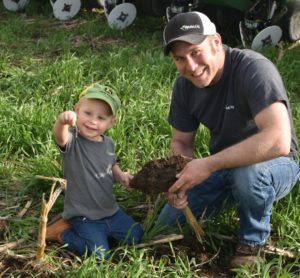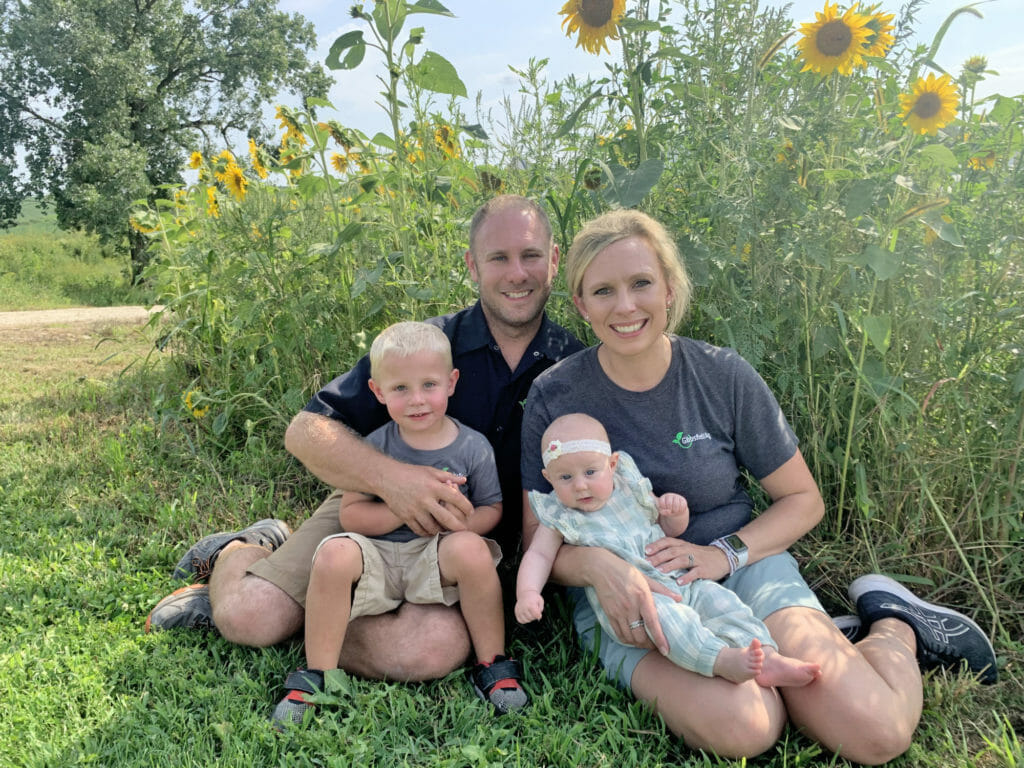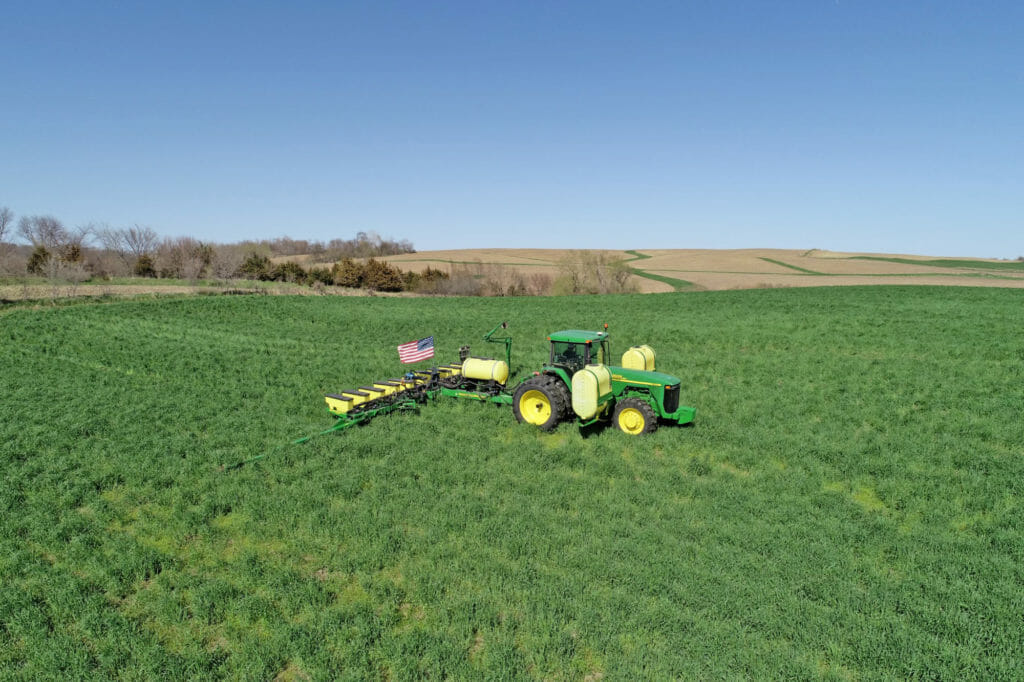Economic Engines
Cover crops are many things. During the cold months of winter and early spring, they’re like green shrouds and sponges, safeguarding soil from scouring winds while living roots soak up nutrients left unused by summer crops.
In the wet warm season, they are soil anchors during heavy rain. To soil compacted by heavy wheels, they are like drills, boring breathing spaces into the hardpan. To livestock, they are nutritious forage, while to soil microbes, they are harbingers of soil health – a visible cue to unseen transformations happening below ground.
For farmers like Ryan Gibbs, cover crops are also economic engines. Beyond their other benefits, these crops are increasingly underpinning new farm business enterprises that have local and far-reaching impacts.
Growing the Farm With Cover Crops
Ryan and his wife, Kristy, raise corn, soybeans, cereal rye, buckwheat, feeder cattle and contract and pasture pigs at Gibbsfield Farms near Worthington, Iowa. In 2019, they added a new enterprise – Gibbsfield Ag – to provide cover crop seed and services to farmers in their area of northeastern Iowa.
“The seed business ties in hand-in-hand with my farming operation,” Ryan says, “because we are growing cover crops on our farm and I’m able to share what I’ve learned with my customers.”
Ryan grows rye and buckwheat for seed, and he handles all the custom cover crop application for Gibbsfield Ag himself. To provide customers with a full array of seed options, the business also relies on relationships with other local seed companies, like Iowa Cover Crop, to reliably offer over 100 varieties of seed. “My busiest time is in the fall, he says, “when I’m delivering and planting cover crops into the night and combining [crops on my farm] all day.”

He and Kristy got started with cover crops in 2017, as part of a farm transition to no-till that included adding cover crops to their farm. The following year, Ryan started working as a dealer for Iowa Cover Crop. “The second year, we expanded again and put in an LLC to protect ourselves,” Ryan says.
Gibbsfield Ag has expanded rapidly since then. Ryan now uses a 30-foot grain drill to do custom seed applications and hires aerial seeding for some of his customers. His neighbor also cleans seed for him, and he is continually adding storage and other infrastructure to build capacity.
“I wanted to expand my operation with a different crop aside from corn and beans,” Ryan says. “Since I was already a seed dealer, I had a market for my own cover crop seed.”
In 2022, with his cover crop seed business growing, Ryan enrolled in PFI’s Cover Crop Business Accelerator. Participants in the program, which is run in partnership with Iowa Soybean Association, receive customized business support about how to build a viable business plan, market to customers and set strategic goals.
“We were looking at income expansion and were asking: Where should we invest or expand to get the best return on investment?” Ryan says. “We got some great advice through this program.”
Driving Healthy Soils and Resilient Communities
Nurturing more cover crop businesses like this is a key reason why PFI and ISA started the Cover Crop Business Accelerator in 2020. Not only do these businesses help farmers diversify their incomes, they create new opportunities in rural communities. Vitally, they are also helping farmers plant cover crops on more acres – which is essential for Iowa to reach water quality goals spelled out in the state’s nutrient reduction strategy.
The Iowa Nutrient Reduction Strategy, adopted in 2013, calls for a 45% cut in levels of nitrogen and phosphorus that move from Iowa watersheds into the Mississippi River Basin, and eventually the Gulf of Mexico, where they contribute to a vast area that’s unable to support marine life. Cover crops are one of the key practices outlined in the strategy. But farmers face a range of barriers to adding or expanding cover crop acres – including access to cover crop seed.
That’s one reason why businesses like Gibbsfield Ag are so critical.
“Cover crops contribute to rural Iowa communities by improving water quality,” Ryan says. “When farms flood, that’s the same water that travels through all of these communities taking the topsoil away.”
Keeping soil in place is one reason Ryan wants to see more cover crops in his community. But he also sees their potential to improve water quality and food systems. “Employing cover crops is part of a larger societal benefit,” he says. “Healthier soil means a better-quality cash crop, and that means more nutrient-dense food and healthier living.”
Through Gibbsfield Ag, Ryan hopes he can help customers find ways to make cover crops feasible on their farms. By addressing some of his customers’ barriers and concerns, he sees the potential to unlock a cascade of cover crop acres – with improved water quality, healthier rural communities and more resilient farms following in tow.
“For us, resiliency means making each acre the most profitable it can be while cutting back on certain inputs,” Ryan says. Diversifying rotations and revenue streams is Ryan’s approach to building resiliency on his farm. “We sell cereal rye, we have hogs, we have cattle – so even if two markets fail, we won’t ruin our business.”
Growing Pains – and Plans
Ryan’s cover crop enterprise is healthy and expanding, but as with any business, he has faced challenges.
“The most challenging aspect of the business right now is dealing with changing prices and logistics,” Ryan says, describing high trucking and fuel prices that fluctuate often. “Our quotes were changing, and it isn’t ideal when you’re trying to make customers happy. Just trying to keep costs down and stay competitive was the biggest challenge last year.”
While Ryan maintains many partnerships with local businesses and neighbors to help spread out some of the work, Gibbsfield Ag is still owned and operated by Ryan alone. “I’m a one-man show,” he says. “I’m trying to make things efficient and balance everything with the farming operation.”
In the near future, with work already busy and growth looming, Ryan says that hiring an extra set of hands – or two – is a priority. “In five years, I would like to have a warehouse and office space, two to three employees, more capacity for marketing and finance, and online sales traffic for small-scale seed sales nationwide.”
As his business expands, another goal is getting more cover crops in the ground and sharing his knowledge with fellow farmers along the way.
“I want to increase my presence teaching people and educating farmers on the feasibility of cover crops,” Ryan says. “I have numerous farmers that I’m helping with paperwork, maps of fields, tickets for purchasing seed, planting fields, germ tests – I want to give everyone all of the information they need.”
Ultimately, Ryan’s goal with Gibbsfield Ag is about building up rural communities – with cover crops as the foundation for healthier soil and water, healthier food and healthier communities for people to work, connect and enjoy Iowa life.
Cover Crop Business Accelerator Program
The Cover Crop Business Accelerator program couples funding with customized business support to help emerging cover crop seed and application businesses grow and flourish. Started in 2020 between PFI and Iowa Soybean Association, the program has helped 40 businesses across Iowa to date. In 2022, these businesses seeded over 135,000 acres of cover crops, grew over 3,000 acres of seed and added 14 full- or part-time employees to their operations.
Get involved
PFI will be accepting 15 businesses into the Cover Crop Business Accelerator in 2023.
For questions about the program, contact Lydia English at (515) 232-5661 or lydia.english@practicalfarmers.org.



